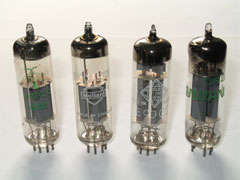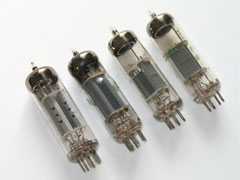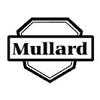Buy Boards & Parts:
www.beezar.com
www.beezar.com

The ECP Audio
T
O R P E D O
parafeed headphone amplifier
The 5920/E90CC Tube and its variants
 |

From Left to Right:
Russian E92CC, Mullard E90CC, Telefunken E90CC, Sylvania 5920 |
A recent discovery has led to a new tube for use in the TORPEDO! Jim Cross, of "Vacuum Tubes Inc." recently suggested the use of the 5920 (E90CC) in the Torpedo amp as a superior replacement to the 6J6. Boy, was he right! The 5920/E90CC tube pushes the TORPEDO! into an entirely different level of detailed performance. Some have said it makes the Torpedo sound like a $1,000 amplifier. We don't know for sure about that, but there is no doubt these tubes are a level above the 6J6 family of triodes. |
| The history of this tube is that they were manufactured for the early computers and calculators. The IBM CPC was one of these. Here's a link from the National Valve Museum: National Valve Museum - E90CC (5920). The data sheet for this tube type even states that these tubes are not for audio, but extensive use has confirmed that these tubes do not tend toward microphonics at all. In fact, they have proven to be the finest tubes available for use in the TORPEDO! | 
E90CC/5920 plate struture from Left to Right:
Telefunken E90CC, Sylvania 5920, Mullard E90CC, Russian E92CC |
|
| Like the 6J6 tube, the E90CC is a dual-triode tube rated at a maximum of 300V on the plates. For the TORPEDO! parafeed headphone amplifier, the triodes in each tube are paralleled, with the power transformer voltage providing the plate voltage at 200V, about twice the normal operating recommendation (100V). The result is a high-voltage tube circuit that is more or less self-balancing for the tube pairs. |
||
|
Physical differences between the 5920/E90CC and the 6J6 are immediately obvious in one respect: height. The 5920/E90CC is a much taller tube. So tall, in fact, that you may roll tubes of this type in the Torpedo without ever removing the case lid. Electrically, it has the following basic differences from the 6J6 when run at 100V on the plates: |
||
|
In the photos above, one can see the wide variances in plate design from one mfr to another. Some more or less continued the plate design and size of the 6J6 with a much taller bottle and correspondingly taller getter suppor. Others increased the size of the plates to fill the bottle more naturally. I have yet to be able to distinguish any performance differences from one plate design to the other, although the Telefunken and Mullards seem to outshine the rest. In addition, the bottle itself varies from mfr to mfr. While each are the same height, some mfrs produced what is now referred to as a "pinched waist." Pinched waist bottles also tended to have glass-folding seams on the top, but these also exist in non-pinched-waist versions, as well. Also included in the same family of tubes is the E92CC. It has a similar history to the E90CC here: Valve Museum - E92CC One of Russian make is included in the photos above. Its plate resistance is higher at 8300 ohms and seems to perform more like a highly-detailed 6J6 rather than an entirely different level of performance as gained with the E90CC. Still, you may find better deals on the E92CC, so we've included the data sheet info here, also. | ||
file last changed:Monday, May 27, 2024 12:25:39 PM
Please contact the TORPEDO webmaster for questions about these web pages.




